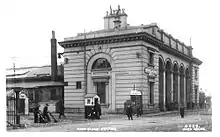Nine Elms | |
|---|---|
 The terminus in 1838 | |
| General information | |
| Location | Nine Elms, London Borough of Lambeth England |
| Platforms | 2 |
| Other information | |
| Status | Disused |
| History | |
| Original company | London and Southampton Railway |
| Pre-grouping | London and South Western Railway |
| Key dates | |
| 21 May 1838 | Opened |
| 11 July 1848 | Closed to passengers |
| 29 July 1968 | Closed to freight |
Nine Elms railway station in the London district of Battersea was opened on 21 May 1838 as the London terminus of the London and Southampton Railway which on the same day became the London and South Western Railway. The building in the neoclassical style was designed by Sir William Tite. The station was inconveniently situated for travel to central London, with the necessity to complete the journey by road or by the steam boats connecting the station to points between Vauxhall and London Bridge.[1]
The station was closed to passengers from 11 July 1848 when the L&SWR opened its metropolitan extension, the Nine Elms to Waterloo Viaduct from Nine Elms to Waterloo (then called Waterloo Bridge Station), and the area adjacent to the station housed the L&SWR's carriage and wagon works until their relocation to Eastleigh in 1909.[2] After closure to passengers the station and surrounding tracks continued in use for goods traffic.
In 1941 the building was damaged by German bombs and it was demolished in the 1960s. The station closed as a freight depot on 29 July 1968.[3] The site became the flower section of the New Covent Garden Market in 1974.[4]
| Preceding station | Historical railways | Following station | ||
|---|---|---|---|---|
| Clapham Common | London & South Western Railway (1838–1848) |
Terminus | ||
Gallery
 Detail from a map of 1847 showing the station
Detail from a map of 1847 showing the station Nine Elms station, when in use as a goods station, adapted from an old photograph dated about 1905.
Nine Elms station, when in use as a goods station, adapted from an old photograph dated about 1905.
References
- ↑ Nine Elms Station, image and information at Science and Society
- ↑ Mitchell, Vic; Smith, Keith (1988). Waterloo to Windsor. Middleton Press. p. 18. ISBN 0-906520-54-1.
- ↑ Chronology of London Railways by H.V. Borley ISBN 0 901461 33 4
- ↑ "Heritage - Nine Elms". Nine Elms on the South Bank. Retrieved 7 March 2013.
